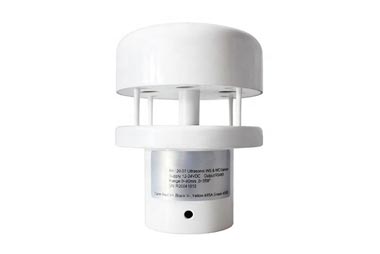In many occasions, such as mines, forests, weather monitoring, etc., ultrasonic anemometers are required. The ultrasonic anemometer is designed based on the principle of ultrasonic vortex. The ultrasonic transducer is used to send and receive signals, and then equipped with a hardware processor chip. As a controller, it can realize the functions of wind speed detection, display, remote control and remote transmission. Ultrasonic wind speed sensors also play a very important role in our daily life.
This is a low-cost, high-precision, high-stability wind speed sensor. The system can accurately provide downhole wind speed and air volume data in real time, and can be set remotely. The diversified output interfaces are convenient for the connection of sensors and base stations. Its principle is to use an ultrasonic rotary transducer to obtain the wind speed. A blocking body is arranged between the wind speed sensor and the transducer. When the flowing air passes through the blocking body, two rows of vortices with alternating internal rotations are generated under the blocking body.

Due to the blocking effect of the vortex on the ultrasonic wave, the ultrasonic transducer will receive the ultrasonic wave whose intensity varies with the frequency of the vortex. When the vortex does not block the ultrasonic wave, the received ultrasonic wave has the highest intensity. When the vortices just block the ultrasonic waves, the received ultrasonic waves have the least intensity. The ultrasonic transducer sends the received frequency signal to the frequency/voltage conversion module, and converts it into a voltage. The two are in a linear proportional relationship, that is, the voltage and the wind speed are in a linear proportional relationship.
Ultrasonic anemometer is mainly composed of ultrasonic signal transmitting/receiving module, frequency/voltage conversion module, various output modules, watchdog module, infrared remote control module and liquid crystal display module. Provide excitation to the ultrasonic transducer through the signal sending module, and transmit ultrasonic signals. The ultrasonic transducer will receive the ultrasonic signal whose intensity varies with the vortex frequency and send the signal to the frequency/voltage conversion module. After converting into the corresponding voltage, It is sent to the single-chip microcomputer for A/D sampling, and finally processed by the single-chip microcomputer.
Ultrasonic wind speed sensor includes software, hardware, and algorithm design. The hardware includes the ultrasonic signal sending module, the signal acquisition and processing module, the output and peripheral modules of the ultrasonic wind speed sensor, etc. The software and software are mainly to realize the writing of the drivers of the above hardware modules. The algorithm adopts the fitting algorithm, such as linear least square fitting, nearest neighbor difference and equal stripe difference and so on.
Ultrasonic anemometers not only bring data to people in many places, but also guarantee safety. For example, in mines, mine accidents frequently occur. Therefore, to increase underground safety, it is required that underground equipment can accurately and timely transmit underground data. However, the traditional methods for the measurement of wind speed and air volume often have problems such as low accuracy, high cost, and poor stability. The emergence of ultrasonic wind speed sensors not only facilitates us to accurately collect data, but also ensures the safety of personnel and property.
